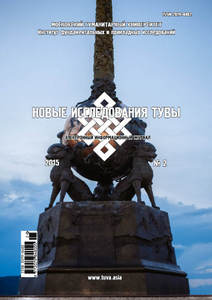About the typological links between the Kalmyk and Balkar folklore (case study of child songs)
Keywords:
Kalmyk folklore; Balkar folklore; cumulation; typologyAbstract
Article analyzes the child folklore pieces "I have been walking in bright lunar night” (Kalmyk) and "I have been walking and walking and found some wool” (Balkar). These examples show the typological links between the Kalmyk and Balkar verba traditions, reveal common elements in texts.References
Altn cheeҗtә kelmrch Boktan Shania (Khranitel' mudrosti narodnoi Shania Boktaev) (2010) /comp. B. B. Mandzhieva. Elista, KIGI RAN. 172 p. (In Russ.).
Antologiia balkarskoi poezii (1993) / tr. Z. Kuchukova. Nal'chik: El'brus. (In Russ.).
Basangova, T. G. and Burykin, A. A. (2001) O tipologicheskom izuchenii magicheskoi poezii kalmykov: kalmytsko-tunguso-man'chzhurskie fol'klornye i etnokul'turnye paralleli. Vestnik Kalmytskogo instituta gumanitarnykh issledovanii RAN, no. 16, pp. 53–67. (In Russ.).
Basangova, T. G. (2009) Detskii fol'klor kalmykov. Elista, KIGI RAN. 72 p. (In Russ.).
Basangova, T. G., Mandzhieva, B. B. (2011) K voprosu o sokhrannosti teksta odnoi kumuliativnoi skazki. Vestnik KIGI RAN, no. 1, pp. 177–181. (In Russ.)
Burykin, A. A. (2002) Pochemu rukoiatka pleti Khongora sdelana iz odinokogo kizilovogo dereva? (eshche odin etnograficheskii kommentarii k motivam «Dzhangara»). In: Kalmyki i ikh sosedi v sostave Rossiiskogo gosudarstva. Elista, APP «Dzhangar». Pp. 162–164. (In Russ.)
Gatsak, V. M. (1989) Ustnaia epicheskaia traditsiia vo vremeni: Istoricheskoe issledovanie poetiki. Moscow, Nauka. 256 p. (In Russ.).
Dzhangar. Kalmytskii geroicheskii epos (1978) / comp. A. Sh. Kichikov; ed. G. I. Mikhailov. Moscow, Nauka, Glav. red. Vost. lit., vol. 1. 441 p. (In Russ.)
Dushan, U. (1976) Obychai i obriady dorevoliutsionnoi Kalmykii. Etnograficheskii sbornik, vol. 1. Elista. Pp. 5–88. (In Russ.)
Zhangar (1980) Takil Zula khaani achi Tangsag Bumba khaani zhichi uzen Aldar khaani kobuun uiein onochin Zhangariin tuuli arban tabun bolog. Urumchi, Shinzhiiangiin "Shinkhuva” kevlel. 647 p. (Na oirat. pis'm. «todo bichig»). (In Russ.).
Kapaev, I. S. (2012) Nogaiskie mify, legendy i pover'ia. Opyt mifologicheskogo slovaria. Moscow, Golos-Press. 424 p. (In Russ.)
Mandzhieva, B. B. (2011) Kumuliativnaia skazka u kalmykov (sinopticheskii analiz raznovremennykh tekstov). Nauchnaia mysl' Kavkaza, no. 1(65), vol. 2, pp. 100–106. (In Russ.)
Nosov, D. A. (2010) Mongol'skaia narodnaia kumuliativnaia skazka. Mongolika IX. St. Petersburg, Peterburg ; Vostokoved. Pp. 84–89. (In Russ.).
Ochirov, N. (2006) Zhivaia starina. Elista, Kalm. kn. izd-vo. 398 p. (In Russ.)
Propp, V. Ia. (1976) Fol'klor i deistvitel'nost'. Moscow, Nauka. 330 p. (In Russ.)
Saglr eeҗin tuul's (Skazki babushki Saglar) (2002) / comp. T. G. Bordzhanovoi. Elista, Kalm. kn. izd-vo. 44 p. (In Kalm.).
Khal'mg tuul's (1968). Kalmytskie narodnye skazki : in 4 vol. Elista, Kalm. kn. izd-vo. Vol. 2. 266 p. (In Kalm.).
Erdniev, U. E. (1985) Kalmyki. Elista, Kalm. kn. izd-vo. 282 p. (In Russ.)
Kalmyk Folk Culture in the mid-19th Century (2011). Philological Studies on the Basis of Gabor Balint of Szentkatolna`s Kalmyk Texts. Budapest : Library of the Hungarian Academy of Sciences. 380 p.
Published
How to Cite
Issue
Section

Author(s) license holder(s) grant rights for their work to the journal (grantee of a license) under the simple non-exclusive open license in accordance with Art. 1286.1 «Open license for a research work, work of literature or fine arts», Civil Code of the Russian Federation.
New Research of Tuva publishes articles under the Creative Commons Attribution-NonCommercial license (CC BY-NC).
Since it is an open license, author(s) reserve the right to upload the article to their institutional repository, submit it to another journal (if it allows republications), or republish it on their own website (in full, or in part).
However, several conditions apply here:
a) The republished version must always contain the name(s) and affiliation(s) of the author(s), the original title and the hyperlink to the original version on the New Research of Tuva website;
b) It must be in open access, free of charge, and no category of readers must be in any way whatsoever advantaged over general readership.
c) should the contribution be submitted elsewhere by its author(s) without substantial modification (30% or more of original text unchanged), the body of the article should contain a disclaimer that the original version was published in New Research of Tuva (with a link to the respective page)
The CC-BY-NC is a non-revocable license which applies worldwide and lasts for the duration of the work’s copyright.




